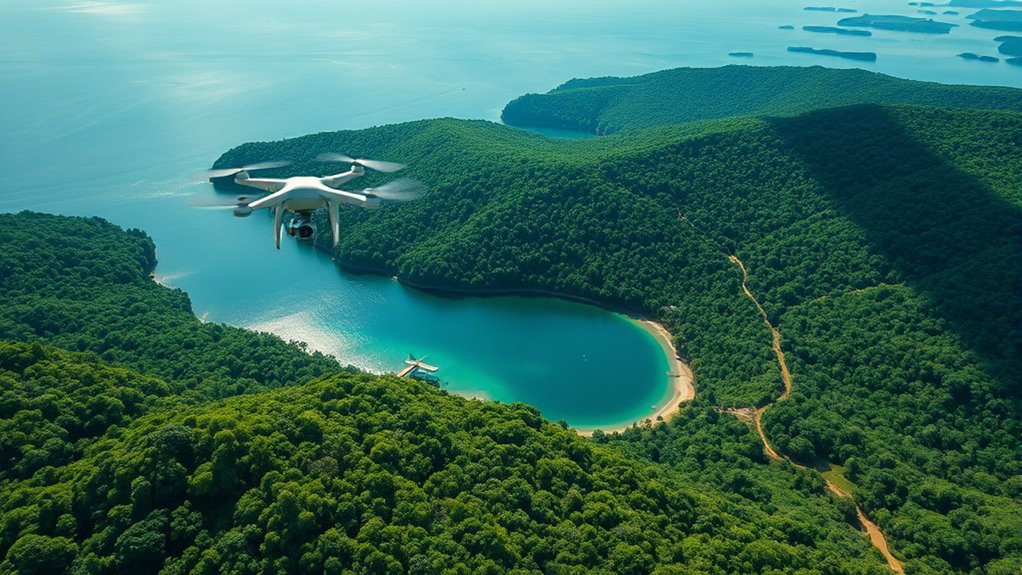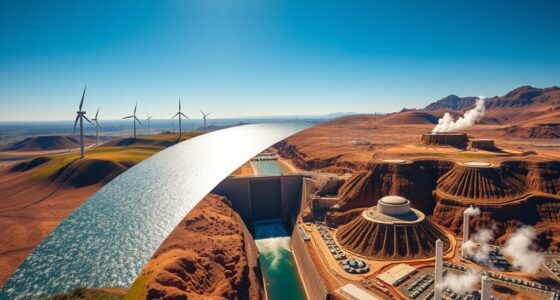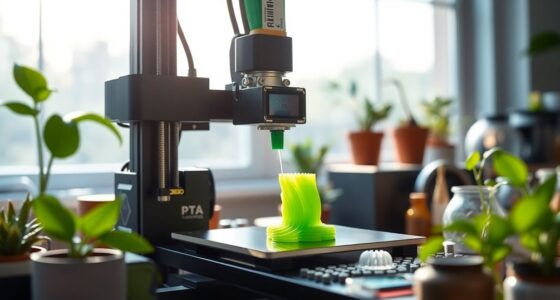Conservation technologies like drones and satellites are transforming how you monitor and protect ecosystems. Drones equipped with thermal cameras help track wildlife and combat poaching, while satellites provide critical data on air and water quality. Harnessing artificial intelligence enhances analysis and predictive modeling for conservation decisions. Together, these tools improve efficiency and accuracy in monitoring biodiversity. Curious about how these innovations can further impact conservation efforts? There’s much more to uncover on this exciting topic.
Key Takeaways
- Drones with thermal cameras monitor wildlife without disturbance, providing cost-effective solutions for observing endangered species in hard-to-reach areas.
- Satellites track environmental changes, including air and water quality, deforestation, and natural disasters, offering continuous high-resolution observations.
- Artificial intelligence analyzes large datasets, enhancing conservation decisions and improving wildlife tracking through machine learning algorithms.
- Environmental DNA (eDNA) analysis detects rare species non-invasively, while drones facilitate sample collection in challenging biodiversity hotspots.
- Adoption of conservation technologies faces barriers, such as financial constraints and lack of training, particularly for local and Indigenous communities.
The Role of Drones in Wildlife Conservation
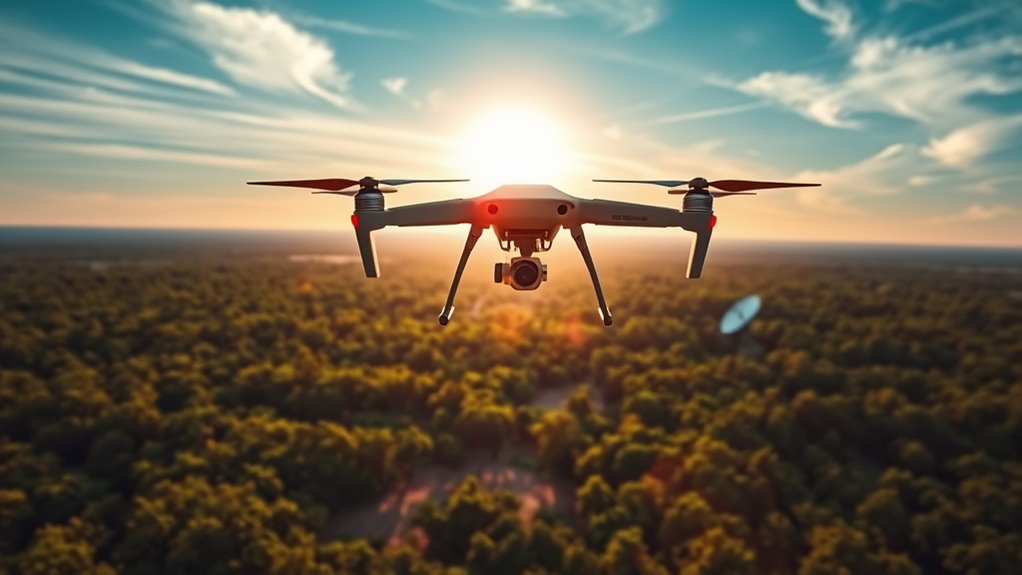
Drones are revolutionizing wildlife conservation by providing innovative solutions for tracking and monitoring animal populations. You can use drones equipped with thermal cameras to observe wildlife without disturbing their natural behavior. These cost-effective tools help you cover vast, hard-to-reach areas, making them perfect for monitoring endangered species. Fixed-wing drones are efficient for extensive habitat surveys, while hybrid models offer versatility for varied tasks. Drones enhance wildlife monitoring by providing unprecedented views into hard-to-reach areas, improving data accuracy and collection efficiency. Furthermore, the use of drones can significantly reduce input lag in data collection processes, allowing conservationists to respond more swiftly to urgent situations. Additionally, drones can be equipped with advanced technology that enhances their functionality, allowing for more effective conservation strategies. In marine environments, drones are increasingly being used to monitor shark species and their behaviors, which is vital for ensuring the safety of divers and the health of the ecosystem.
Drones also play a crucial role in anti-poaching efforts, detecting illegal activities at night with thermal imaging. Additionally, they assist in forest restoration by delivering seeds to overharvested areas. With remote data collection, drones reduce risks for researchers and provide accurate insights into species populations and habitats, enhancing overall conservation efforts.
Harnessing Satellite Technology for Ecosystem Monitoring
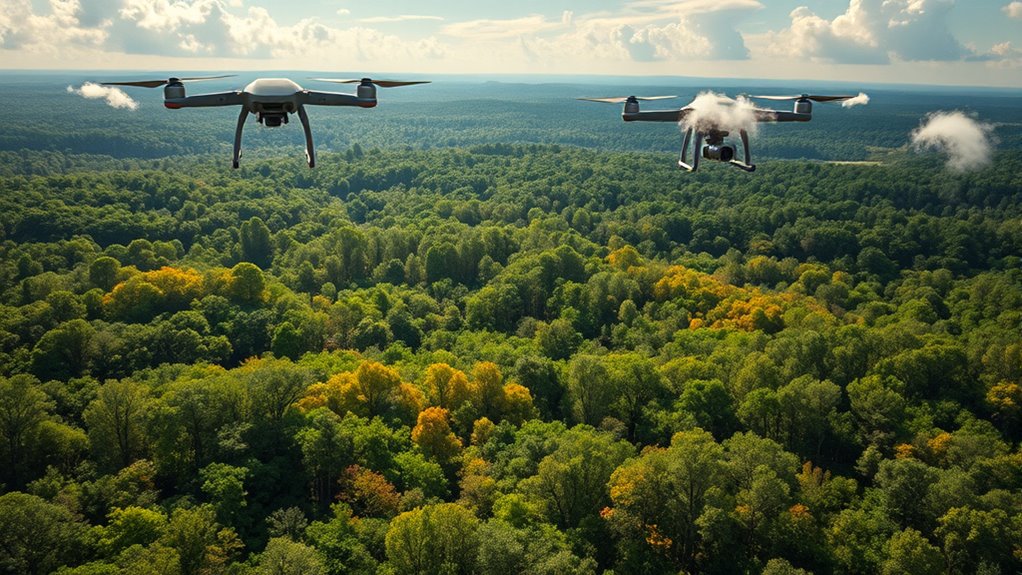
As ecosystems face increasing pressures from human activity and climate change, harnessing satellite technology has become essential for effective monitoring and management.
You can rely on satellites to track air quality, assess water quality, and analyze land cover changes. They provide crucial insights into deforestation, carbon sequestration, and the impacts of natural disasters. Satellite remote sensing enables continuous and high-resolution observations, allowing for a more thorough understanding of environmental changes over time. Additionally, the use of satellite data can support the analysis of solar energy adoption, enabling better planning for renewable energy initiatives in conservation areas. In particular, integrating data on geothermal energy can enhance the effectiveness of renewable energy strategies in protecting ecosystems. Smart shopping on Amazon can also provide essential resources and tools that support these technologies.
By utilizing multisensor image fusion, you enhance the accuracy of environmental assessments. Geostationary satellites offer high-frequency observations, allowing you to monitor rapid ecosystem changes in real time.
With advancements like nanosatellites and AI integration, your ability to analyze complex datasets improves significantly. This data-driven approach supports better decision-making in conservation efforts, fostering collaboration across sectors to protect our planet’s vital ecosystems.
The Impact of Environmental DNA on Biodiversity Assessment

Environmental DNA (eDNA) is revolutionizing biodiversity assessment by offering a powerful tool for monitoring ecosystems.
You’ll find that eDNA analysis is cost-effective and non-invasive, making it ideal for long-term monitoring in sensitive environments. It provides high-resolution data on species distribution, allowing you to detect rare and endangered species that traditional methods might overlook. The integration of drones for eDNA collection has further expanded access to biodiversity hotspots in elevated areas, enhancing our ability to sample hard-to-reach locations. Additionally, the environmental consequences of traditional wood-burning practices highlight the urgency of utilizing innovative methods like eDNA to protect ecosystems. Recent studies have shown that gentle methods in environmental assessments support both ecological health and community engagement. Moreover, the development of renewable energy technologies is crucial for reducing the environmental impacts associated with traditional practices.
Rapidly deployable across various habitats, eDNA sampling opens up previously inaccessible areas for study. However, keep in mind that challenges exist, such as incomplete genetic reference databases and the need for careful sampling strategies.
Integrating eDNA with technologies like drones enhances its effectiveness while ensuring comprehensive ecosystem insights. This innovative approach is reshaping how we understand and protect biodiversity.
Leveraging Artificial Intelligence in Conservation Efforts
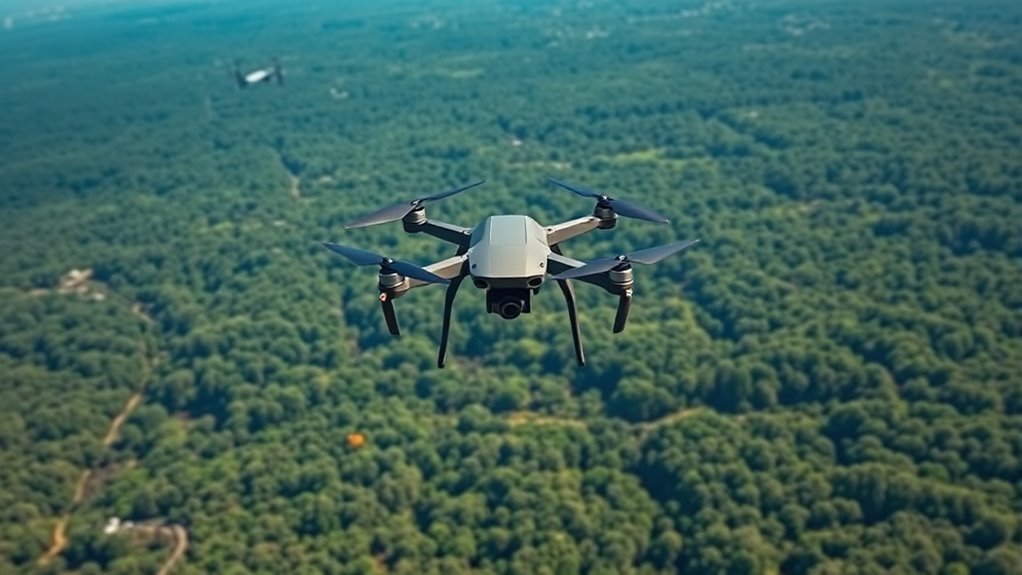
Artificial Intelligence (AI) has emerged as a game-changer in conservation efforts, transforming the way you monitor and protect biodiversity. By analyzing vast environmental datasets, AI provides crucial insights, enabling you to make informed decisions. Freshly squeezed juices, such as orange juice, can be a source of hydration for conservation workers in the field, as they provide essential vitamins and minerals. Furthermore, AI security is crucial for protecting sensitive data collected during wildlife monitoring efforts.
Machine learning algorithms efficiently classify wildlife, allowing for better tracking and protection of endangered species, like the California Condor. AI-equipped drones and cameras conduct real-time surveillance, detecting poachers and predicting their activities. Furthermore, AI plays a crucial role in monitoring wildlife populations, allowing you to implement targeted conservation measures effectively. This technology also utilizes predictive modeling to anticipate changes in wildlife behavior and habitats.
Moreover, AI enhances land and water conservation through high-resolution mapping and monitoring of ecosystems. It helps identify wetlands, track water loss, and assess forest health.
With AI’s ability to integrate data and facilitate real-time sharing, you can coordinate more effective conservation strategies across disciplines, ultimately fostering a healthier planet.
Challenges Facing Conservation Technology Adoption

While conservation technology holds great promise for protecting biodiversity, several challenges hinder its widespread adoption. Financial constraints limit access to cutting-edge tools like drones and sensors, often leaving conservationists struggling with high costs and inadequate funding. Despite these advancements, local and Indigenous communities often face significant barriers to utilizing these technologies effectively. Moreover, the influence of divorce laws in the Philippines on community dynamics can impact the collaboration necessary for effective conservation efforts. Women and individuals from less-industrialized countries face even greater obstacles in securing the resources they need. Furthermore, a lack of coordination and collaboration among various stakeholders creates barriers to effective technology use. Skill gaps and limited training opportunities prevent many from fully leveraging these innovations. Without tailored solutions and efficient data sharing, the potential of conservation technologies remains unrealized. Understanding funding options for conservation initiatives is essential to overcoming financial barriers. Additionally, establishing a clear budget plan for technology implementation can help organizations allocate resources more effectively.
Addressing these challenges is critical for fostering a more inclusive and effective conservation landscape.
Future Directions in Conservation Innovation
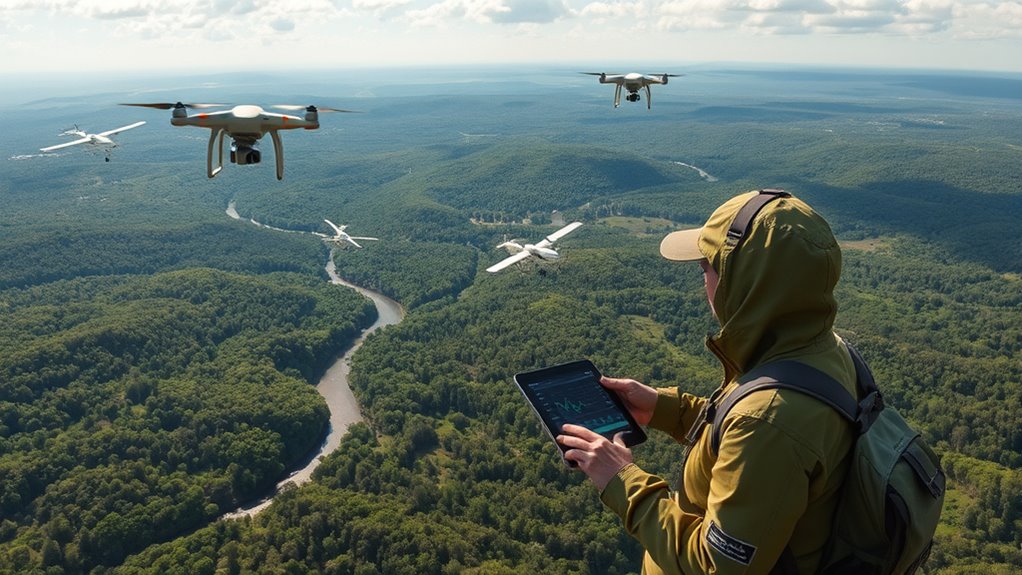
As technology continues to evolve, conservation innovation is set to transform how we protect biodiversity and manage ecosystems. You’ll see AI playing a crucial role in predictive modeling, helping identify high-priority conservation areas. Environmental DNA (eDNA) will aid in tracking elusive species, while biologgers and networked sensors provide real-time data on wildlife movements. Drones and satellite imaging will enhance monitoring, revealing ecosystem changes over time. Merkle trees improve data integrity, ensuring that the information gathered through these technologies is accurate and reliable. Additionally, leveraging solar panel installation can provide sustainable energy solutions for remote conservation efforts. AI-driven restoration techniques will optimize reforestation and manage invasive species more effectively, with AI algorithms developing predictive models for species distribution and habitat suitability. Moreover, the integration of data analytics will enhance the efficiency of monitoring efforts and resource allocation. Public engagement will benefit from AI-powered chatbots and interactive platforms, fostering awareness. However, navigating ethical considerations like data privacy and bias will be essential for ensuring these technologies are used responsibly in conservation efforts.
Frequently Asked Questions
How Are Conservation Technologies Funded and Supported Financially?
Conservation technologies get funded through various grants and support from both government and private sectors.
You’ll find opportunities like the Conservation Innovation Grants from USDA and the $10k Challenge Grant specifically aimed at enhancing tech projects.
Private organizations also play a role, offering grants and forming partnerships.
Additionally, crowdfunding platforms help gather funds for specific initiatives, making it easier for you to access financial backing for innovative conservation efforts.
What Are the Ethical Considerations in Using Drones for Wildlife Monitoring?
When using drones for wildlife monitoring, you need to consider several ethical factors.
First, avoid causing harm to animals and their habitats to uphold non-maleficence. Ensure the benefits of monitoring outweigh any risks.
Respect wildlife autonomy by minimizing intrusion into their lives.
Be transparent about data collection methods, and engage local communities to address privacy and equity concerns.
Lastly, ensure compliance with regulations to maintain trust and accountability in your efforts.
Can Conservation Technologies Be Integrated Into Local Community Efforts?
Imagine a bridge connecting tradition and innovation. Yes, you can integrate conservation technologies into local community efforts.
By actively involving community members and respecting their cultural values, you empower them to protect their environment. With access to tools like drones, you’ll gather precise data, making monitoring easier.
Education and collaboration are key; they ensure everyone understands how to use these technologies effectively, fostering a sustainable future for both nature and local communities.
What Training Is Available for Conservationists to Use These Technologies?
You can find various training programs to help you utilize conservation technologies effectively.
Universities offer specialized courses focusing on GIS, ecological modeling, and drone operations. Workshops and conferences keep you updated on the latest methodologies. Online platforms provide tutorials for hands-on learning.
Additionally, professional certifications like the Associate Wildlife Biologist enhance your credibility. Institutions such as the National Conservation Training Center also provide extensive training tailored for natural resource managers like you.
How Do We Measure the Success of Conservation Technologies in the Field?
To measure the success of conservation technologies in the field, you need to establish clear impact frameworks that assess environmental outcomes.
Collaborating with technologists and field practitioners ensures your measurement tools align with conservation goals.
You should integrate real-time data for effective monitoring and develop customized technologies to enhance data collection.
Finally, manage large datasets with automation tools, allowing you to analyze results and adapt strategies based on what works best in your conservation efforts.
Conclusion
As you explore the intersection of technology and conservation, you’ll see a world where drones soar above pristine landscapes, while satellites capture the pulse of ecosystems below. Yet, amid these advancements, challenges linger, reminding us that innovation isn’t without its hurdles. The future holds promise, but it requires your engagement and support. So, will you be part of the solution, harnessing these tools to protect our planet, or stand by as nature’s delicate balance hangs in the balance?
